When Nat King Cole opened his classic “Christmas Song” with the line “chestnuts roasting on an open fire,” it was with good reason. Food and holiday festivities go hand in hand.
As Black people in the 170 million+ strong diaspora (defined as people of African descent living outside of Africa), many of the foods we now enjoy are a product of our shared West and Central African heritage. Voluntary immigrants from Africa are included in this community and currently comprise 2.1 million people in the United States alone, but the majority of Black people in the diaspora are descendants of the enslaved.
While our ancestors were forcibly separated from the African continent, their connection with the land remained through their culture and cooking traditions. Once scattered throughout the Americas, they combined those traditions with the products available to them on the continent and improvised new variations of foods provided to them by their European enslavers. The results are rich, vibrant dishes that, while called different things, are enjoyed across the diaspora during the holidays. Here are just some examples:
01Rice and peasOur people have all kinds of variations of rice and peas throughout the diaspora, from hoppin’ john in the south to arroz con gandules in Puerto Rico. For the latter, ingredients include chicken broth, tomato paste, various seasonings and sofrito, an aromatic mix of onion, garlic, sweet chili peppers and cilantro. The English counterpart to sofrito is green seasoning but spicier and is also a key ingredient in peas and rice, as it’s called in Trinidad.Hoppin’ John is flavored with pork and thought to bring good luck and prosperity in the New Year. As such, it’s usually paired with collard greens (whose green color represents U.S. money) and corn bread, which is the color of gold. 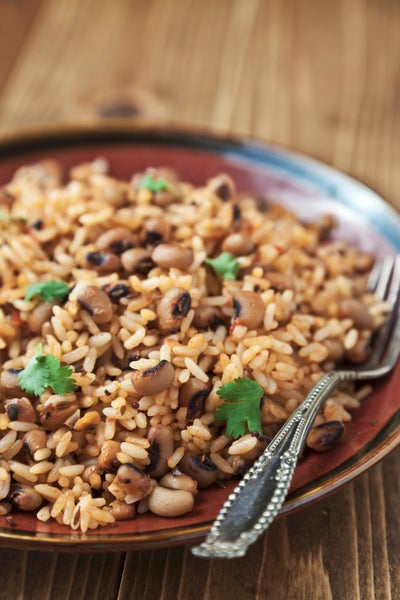 02HamWhile pork wasn’t widely consumed in West and Central Africa, once enslaved Africans landed in the Americas, they were given pork to eat. As a result, pork is a common part of holiday meals throughout the diaspora.
02HamWhile pork wasn’t widely consumed in West and Central Africa, once enslaved Africans landed in the Americas, they were given pork to eat. As a result, pork is a common part of holiday meals throughout the diaspora.
Baked ham is popular in the United States and in various Caribbean countries. Christmas ham in Jamaica is garnished with cloves, pineapples and cherries. In Cuba, people feast on “vieja ropa” (which translates to old clothes) which is shredded pork (or beef) with tomatoes, olive oil, saffron and red wine, served with rice. In Haiti, griot or griyo is a savory fried pork dish that graces the table during the holidays.  03SouseSouse is made from pickled meat, typically the parts of the pig, cow or chicken that aren’t fleshy, for example pig feet, ears and tail are commonly used in souse as are cow or chicken feet.
03SouseSouse is made from pickled meat, typically the parts of the pig, cow or chicken that aren’t fleshy, for example pig feet, ears and tail are commonly used in souse as are cow or chicken feet.
It’s a Caribbean spin on head cheese (a loaf made from cold cuts or jellied meats of a calf or pig’s head) which originated in Europe. The meat in souse is first tenderized through boiling and then marinated in lime, cucumbers, peppers and seasonings to pickled perfection. It’s served cold and enjoyed throughout the Caribbean including Trinidad, Antigua, Guyana and Barbados. 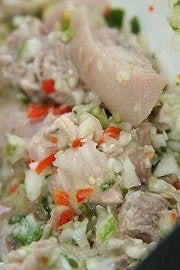 04PastelleA Trinidadian staple, this sweet and savory dish is typically made with minced meat (although it can also be made with chicken or soy) cornmeal and raisins, wrapped up tight in a banana leaf and then steamed. There’s also an exclusively sweet version called Paime made with cornmeal, coconut and raisins.
04PastelleA Trinidadian staple, this sweet and savory dish is typically made with minced meat (although it can also be made with chicken or soy) cornmeal and raisins, wrapped up tight in a banana leaf and then steamed. There’s also an exclusively sweet version called Paime made with cornmeal, coconut and raisins.
Pastelle was brought to the Americas by the Spaniards and is popular in Latin America and the Spanish-speaking Caribbean as well, including Puerto Rico where it’s called pastele. It is so popular there it has its own annual celebration:Festival Nacional del Pastel Puertorriqueno. Variations are also found in Latin America, for example in Colombia where it’s called pastel de arroz. 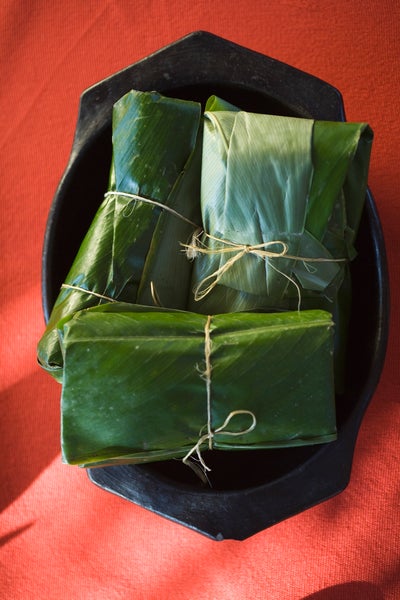 05PepperpotThis Guyanese specialty could even be called Guyana’s national dish! It’s a meat stew frequently made with oxtail but can also be made with goat or chicken. The meat is seasoned with cinnamon, spices, onion, Cassareep—a sauce made from the root vegetable cassava (yuca) and a generous helping of scotch bonnet peppers to give the dish the spicy kick it’s known for. Enjoy it with bread.
05PepperpotThis Guyanese specialty could even be called Guyana’s national dish! It’s a meat stew frequently made with oxtail but can also be made with goat or chicken. The meat is seasoned with cinnamon, spices, onion, Cassareep—a sauce made from the root vegetable cassava (yuca) and a generous helping of scotch bonnet peppers to give the dish the spicy kick it’s known for. Enjoy it with bread. 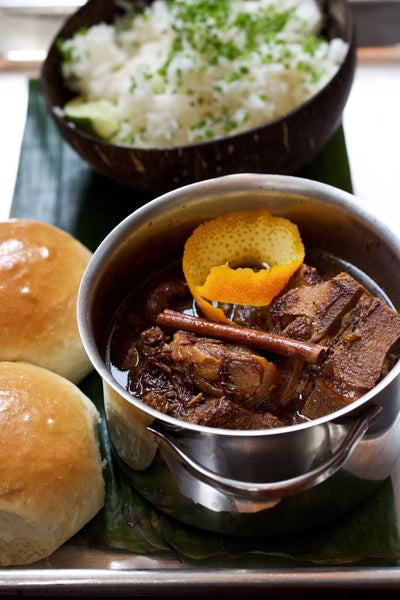 Photo by Deb Lindsey for The Washington Post via Getty Images 06SorrelThis is a drink derived from the hibiscus plant that’s indigenous to Africa and was brought to the Americas during the slave trade. It goes by many names including bissap in Senegal, sobolo in Ghana and agua de Jamaica in Latin America and can be served hot or cold. In the Caribbean however, it is served cold and sweet, typically mixed with sugar or honey, cloves, allspice and, in Jamaica, a healthy serving of ginger.
Photo by Deb Lindsey for The Washington Post via Getty Images 06SorrelThis is a drink derived from the hibiscus plant that’s indigenous to Africa and was brought to the Americas during the slave trade. It goes by many names including bissap in Senegal, sobolo in Ghana and agua de Jamaica in Latin America and can be served hot or cold. In the Caribbean however, it is served cold and sweet, typically mixed with sugar or honey, cloves, allspice and, in Jamaica, a healthy serving of ginger. 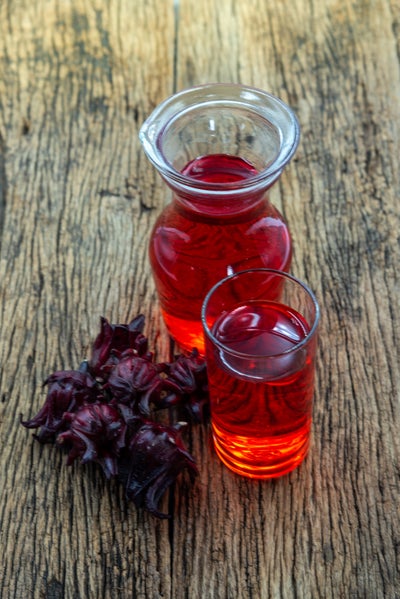 07Ginger beerSpeaking of ginger, if you love to get your tastebuds tingling look no further than ginger beer. Originating in England in the 1700s and brought to the Americas during the slave trade, it’s now an essential Christmas beverage throughout the English-speaking Caribbean. Despite its name however, there is no beer in this drink and it’s non-alcoholic. The ingredients include grated ginger, water, lime juice, sugar and cloves which are combined and left to ferment for up to a week depending on how strong you want it.
07Ginger beerSpeaking of ginger, if you love to get your tastebuds tingling look no further than ginger beer. Originating in England in the 1700s and brought to the Americas during the slave trade, it’s now an essential Christmas beverage throughout the English-speaking Caribbean. Despite its name however, there is no beer in this drink and it’s non-alcoholic. The ingredients include grated ginger, water, lime juice, sugar and cloves which are combined and left to ferment for up to a week depending on how strong you want it.  08Cream punch/Eggnog/CoquitoPonche crema (cream punch) is a Venezuelan beverage that was brought to nearby Trinidad and Tobago which has made it its own. Like American eggnog, it’s made with milk, eggs, sugar, rum and nutmeg but the Trinidadian version includes citrus from Angostura bitters and lime zest, it also jazzes things up a bit with sweetened condensed milk.
08Cream punch/Eggnog/CoquitoPonche crema (cream punch) is a Venezuelan beverage that was brought to nearby Trinidad and Tobago which has made it its own. Like American eggnog, it’s made with milk, eggs, sugar, rum and nutmeg but the Trinidadian version includes citrus from Angostura bitters and lime zest, it also jazzes things up a bit with sweetened condensed milk.
Puerto Rico has its own version called Coquito which swaps out eggs for cream of coconut and coconut milk. Kremas or Cremasse, as it’s called in Haiti, takes the best of these varieties by combining the ingredients of American eggnog (sans eggs) with citrus from the Trinidadian version and coconut from the Puerto Rican version. 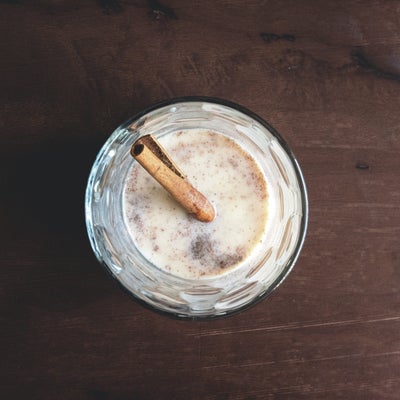 09Black cake/ fruit cakeDerived from British plum pudding (pictured below), black cake can be found throughout the English-speaking Caribbean and owes its Black color to browning, a black syrup with a sweet caramel flavor made from burnt sugar.
09Black cake/ fruit cakeDerived from British plum pudding (pictured below), black cake can be found throughout the English-speaking Caribbean and owes its Black color to browning, a black syrup with a sweet caramel flavor made from burnt sugar.
While Black cake is similar to American fruit cake, it has a key difference: fruit cake contains chunks of fruit, but black cake has fruit that’s been soaked in rum and either ground or blended together. The result is denser and moister than fruit cake. British plum pudding contains dried fruits and brandy to preserve it for up to a year. During the slave trade, brandy was replaced with rum which was readily available in the Caribbean. Black cake goes nicely with a tall glass of sorrel. 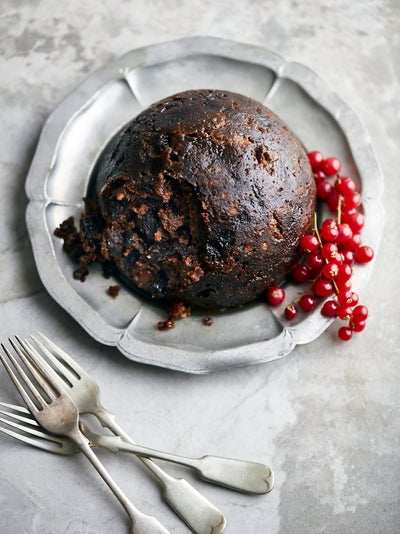 10Pen patatPen patat is a Haitian sweet potato pudding whose ingredients include bananas, white sweet potatoes, raisins, sugar and coconut cream and is a popular dessert during the holidays. Variations of this pudding abound, for example Jamaica has a sweet potato pudding which replaces bananas with yam.
10Pen patatPen patat is a Haitian sweet potato pudding whose ingredients include bananas, white sweet potatoes, raisins, sugar and coconut cream and is a popular dessert during the holidays. Variations of this pudding abound, for example Jamaica has a sweet potato pudding which replaces bananas with yam.
In Trinidad, Christmas isn’t complete without cassava pone, similar in appearance to sweet potato pudding, it’s made with grated cassava, coconut, raisins, brown sugar and cinnamon. It can also be made with sweet potatoes and pumpkin. 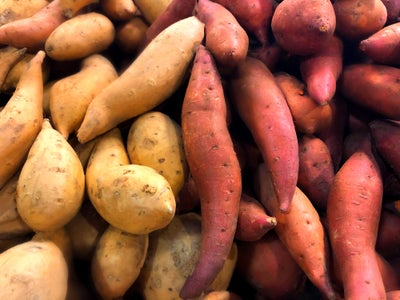 TOPICS: holiday traditions
TOPICS: holiday traditions
The post Look How We Ate That! Did You Know We Share These Holiday Dishes Across The Diaspora? appeared first on Essence.


0 Commentaires